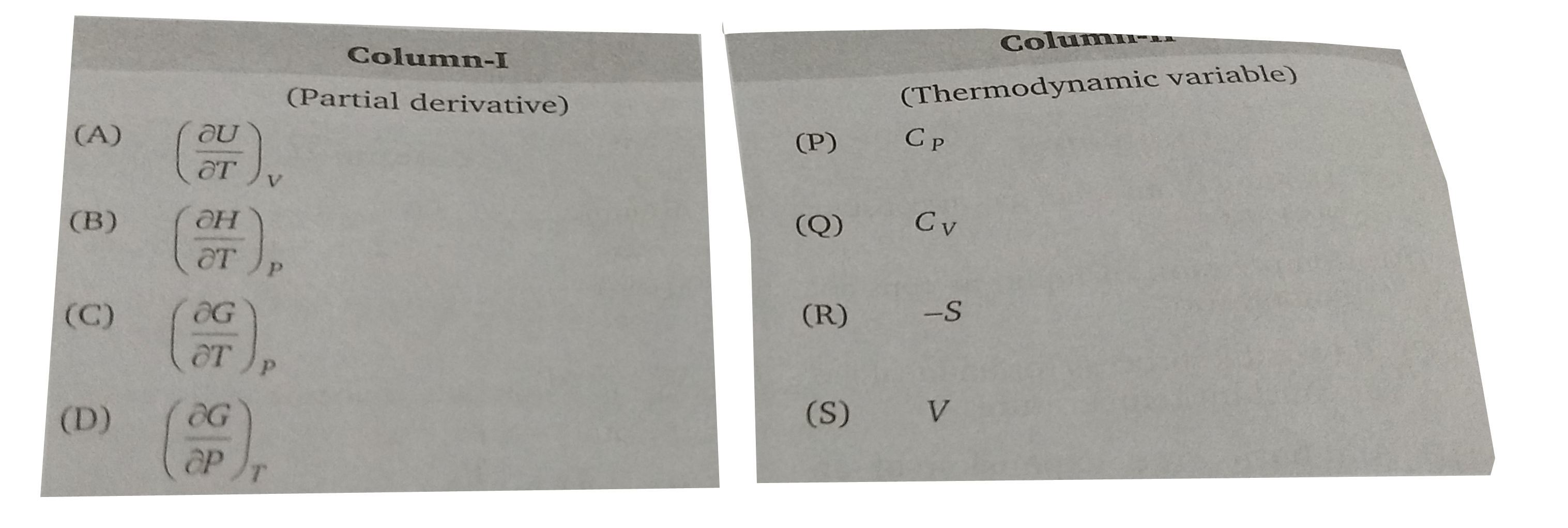Calculate the standard enthalpy of reaction for the following reaction using the listed enthalpies of reaction :
3Co(s)+2O2(g)→Co3O4(s)
2Co(s)+O2(g)→2CoO(s), ΔH∘1=−475.8kJ
6CoO(s)+O2(g)→2Co3O4(s),ΔH∘2=−355.0kJSolution in Punjabi
−891.2kJ
−120.8kJ
+891.2kJ
−830.8kJ
The correct Answer is:A
ΔH∘=32×ΔH∘1+ΔH∘22
=−713.7−177.5
=−891.2 kJ
Topper's Solved these Questions
- BOOK - NARENDRA AWASTHICHAPTER - THERMODYNAMICSEXERCISE - Level 3 - One Or More Answers Are Correct1videos
THERMODYNAMICS
- BOOK - NARENDRA AWASTHICHAPTER - THERMODYNAMICSEXERCISE - Level 3 - Match The Column2videos
THERMODYNAMICS
- BOOK - NARENDRA AWASTHICHAPTER - THERMODYNAMICSEXERCISE - Level 2 (Q.1 To Q.30)1videos
THERMODYNAMICS
- BOOK - NARENDRA AWASTHICHAPTER - STOICHIOMETRYEXERCISE - Level 3 - Subjective Problems20videos
STOICHIOMETRY
Similar Questions
Assume ideal gas behaviour for all the gases considered and neglect vibrational degrees of freedom. Separate equimolar sample. Separate equimolar samples of Ne, O2 , CO2 and SO2 were subjected to a two process as mentioned. Initially all are at same state of temperature and pressue.
Step I → All undergo reversible adiabatic expansion to attain same final volume, which is double the original volume thereby causing the decreases in their temperature.
Step → After step I all are given appropriate amount of heat isochorically to restore the original temperature.
Mark the correct option(s) :04:15View SolutionMatch the following columns
 06:05View Solution
06:05View SolutionWrite structure of 2,2-dimethylheptane.
02:37View SolutionWhat volume of a liquid (in L) will contain 10 mole ? If molar mass of liquid is 280 and its density is 1.4 g/mL.
View SolutionThe enthalpy changes for two reactions are given by the equations: 2Cr(s) +(3)/(2)O_(2)(g) rarr Cr_(2)O_(3)(s), DeltaH^(Theta) =- 1130 kJ C(s) +(1)/(2)O_(2)(g)rarr CO_(2)(g), DeltaH^(Theta) =- 110 kJ What is the enthalpy change in kJ for the following reactions? 3C(s) +Cr_(2)O_(3)(s) rarr 2Cr(s) +3CO(g)
02:51View SolutionCalculate the standard enthalpy of reaction for the following reaction using the listed enthalpies of reaction :
3Co(s)+2O2(g)→Co3O4(s)
2Co(s)+O2(g)→2CoO(s), ΔH∘1=−475.8kJ
6CoO(s)+O2(g)→2Co3O4(s),ΔH∘2=−355.0kJ02:21View SolutionDiborane is formed the element as shown in equation (1) 2B(s) + 3H_(2)(g) rarr 3B_(2)H_(6)(g)"…….."(1) Given that {:(H_(2)O(l)rarrH_(2)O(g),DeltaH_(1^(@))=44kJ),(2B(s)+3//2O_(2)(s)rarrB_(2)O_(3)(s),DeltaH_(2^(@))=-1273kJ),(B_(2)H_(6)(g)+3O_(2)(g)rarrB_(2)O_(3)(s)+3H_(2)O(g),DeltaH_(3^(@))=-2035 kJ),(H_(2)(g)+1//2O_(2)(g)rarrH_(2)O(l),DeltaH_(4^(@))=-286kJ):} the DeltaH^(@) for the reaction (1) is -
12:13View SolutionConsider the reactions
(i) S(rhombic)+3/2O2(g)→SO3(g),ΔH1
(ii) S(monoclinic)+3/2O2(g)→SO3(g),ΔH2
(iii) S(rhombic)+O3(g)→SO3(g),ΔH3
(iv) S(monoclinic)+O3(g)→SO3(g),ΔH411:19View SolutionThe enthalpy of formation of Fe2O3(s) is −824.2kJmol−1.Calculate the enthalpy change for the reaction :
4Fe(s)+3O2(g)→2Fe2O3(s)04:15View SolutionFor a reaction, C(s)+O2(g)→CO2(g)
What is the relation between enthalpy of reaction (ΔHr), enthalpy of formation of CO2(ΔHf) and enthalpy of combustion of carbon (ΔHcomb) ?03:53View SolutionAl(s) and Fe(s) are oxidised by oxygen to form Al2O3(s)andFe2O3(s) respectively. If the standard enthalpy of formation of Al2O3(s)andFe2O3(s) are −1669.8 kJ mol−1and−824.2 kJ mol−1 respectively, calculate the change in enthalpy of the given reaction :
2Al(s)+Fe2O3(s)→2Fe(s)+Al2O3(s)02:51View SolutionDetermine the standard enthalpy of formation of FeO(s) and Fe2(O3(s) from the following data :
3C(graphite,s)+Fe2O3(s)→2Fe(s)+3CO(g),ΔH0=492.6kJ
C(graphite,s)+FeO(s)→Fe(s)+CO(g),ΔH0=155.8kJ
C(graphite,s)+O2(g)→CO2(g),ΔH0=−393.51kJ
CO(g)+12O2(s)→CO2(g),ΔH0=−282.98kJ04:37View SolutionConsider the following reactions. DeltaH^(@) values of the reactions hve been given as -x, -y and z kJ. Fe_(3)O_(4)(s) to 3Fe(s) + 2O_(2)(g), DeltaH^(@) = z kJ 2Fe(s) + O_(2)(g) to 2FeO(s), DeltaH^(@) =-x kJ 4Fe(s) + 3O_(2)(g) to 2Fe_(2)O_(3)(s), DeltaH^(@) =-y kJ Heat of reaction for the reaction, FeO(s) + Fe_(2)O_(3)(s) to Fe_(3)O_(4)(s) is :
02:54View SolutionConsider the following reactions. DeltaH^(@) values of the reactions hve been given as -x, -y and z kJ. Fe_(3)O_(4)(s) to 3Fe(s) + 2O_(2)(g), DeltaH^(@) = z kJ 2Fe(s) + O_(2)(g) to 2FeO(s), DeltaH^(@) =-x kJ 4Fe(s) + 3O_(2)(g) to 2Fe_(2)O_(3)(s), DeltaH^(@) =-y kJ In the given set of reaction, -x//2 kJ refers to
02:59View SolutionThe enthalpy of formation of Fe2O3(s) is −824.2kJmol−1.Calculate the enthalpy change for the reaction :
4Fe(s)+3O2(g)→2Fe2O3(s)03:39View SolutionConsider the reactions (i) S ("rhombic") + 3//2 O_(2)(g) rarr SO_(3)(g), DeltaH_(1) (ii) S ("monoclinic") + 3//2O_(2)(g) rarr SO_(3)(g), DeltaH_(2) (iii) S ("rhombic") + O_(3)(g) rarr SO_(3)(g), DeltaH_(3) (iv) S ("monoclinic") + O_(3)(g) rarr SO_(3)(g), DeltaH_(4)
02:22View Solution

